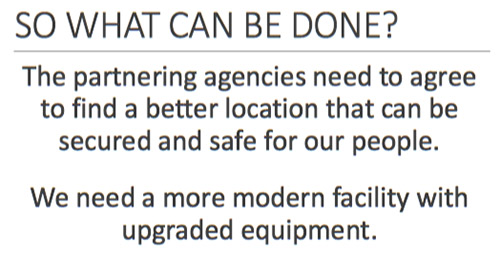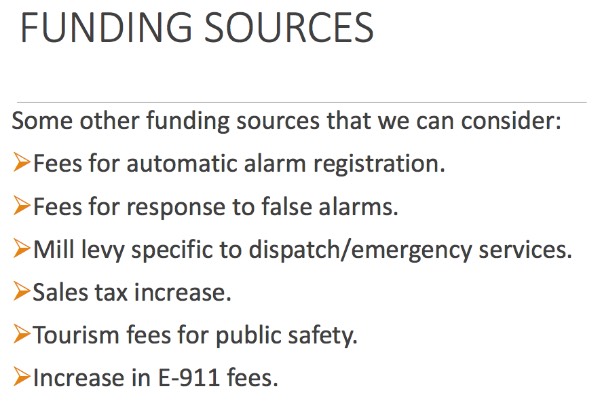“I had someone call in to report a UFO, so we had to send an officer out. A co-worker just had a lady call because she saw peanut shells on the ground, and she wanted the police to come out and pick them up because she was afraid her dog might have an allergic reaction to the peanuts…”
— Tori Dorsey, a 911 dispatcher who has worked at an Indianapolis 911 Call Center for 25 years.
The Pagosa Springs Town Council listened respectfully to Fire Chief Randy Larsen on April 18, as he began his appeal for more money for the Archuleta Combined Dispatch Center. Chief Larsen was speaking on behalf of the operation’s Board of Directors.
“There’s a lot of people who have no idea what a dispatch center is, and how important it is to the emergency response throughout the community. We’re in the process, as a board, of coming up with the possibility of a new dispatch center for our town. The current dispatch center needs to be replaced. It needs upgrades. We really haven’t made any changes to the facilities or the equipment in a long time; it’s starting to age out. And the location right now is really not conducive for a dispatch center. There’s a lot of issues with where it is, that we have to deal with…”
Chief Larsen briefly outlined the shared governance and funding structure of the Center. He then listed off the key issues.
The Center is located in a shopping mall, with security challenges and air quality issues, he told us.
“As far as security, there’s not much we can do. And security is a big deal when it comes to dispatch centers.” As he spoke, Chief Larsen shared a number of Powerpoint slides. (You can download the full slideshow here, as a PDF file.) One of the slides mentioned the idea of a new facility, with new equipment.
The presentation did not, however, give us an estimated dollar figure. What would a “new facility” and “new equipment” cost the taxpayers? Which particular taxpayers would be responsible for providing this extra money? The Chief did not offer specific suggestions in that regard, other than a list of possible funding sources. (A realistic dollar figure might have been helpful to the conversation.)
For example: an increase in E911 fees. This funding source has multiple challenges, however. Currently, E911 fees are collected and distributed according to the phone number’s Area Code. In our increasingly mobile culture, people using cell phones typically keep their phone number even when they move to a new community. You might think this would eventually bring about a level playing field, because people bringing ‘foreign” phone numbers into Archuleta County would be balanced by people taking a Pagosa phone number to a ‘foreign’ city. But that’s just an assumption on my part.
Another problem with E911 fees: some governments have been known to “skim off” E911 funding and use it for unrelated government purposes.
Other funding sources? Sales taxes. A property tax mill levy. Penalty fees for false alarms. Fees charged to visiting tourists. Fees charged for the installation of automatic alarm systems.
At the end of his presentation, Chief Larsen stated that he normally expects any person complaining about a problem to also suggest possible solutions.
“I am going to break that rule tonight, because I have no solutions. We’re working on it. The Board is working on it. We’ve been discussing it, sometimes heatedly, for well over a year now. But we’ve not come up with anything solid, that we can do. We’re asking for help. We’re asking for support.”
A couple of curious thoughts have come to me, while writing this editorial series. Chief Larsen told us that the Combined Dispatch Center fielded more than 8,000 E911 calls last year. That number, he said, included only the initial 911 call; sometimes the 911 caller made follow-up calls. Chief Larsen guessed that Combined Dispatch probably answered more than 10,000 E911 calls last year, all told.
And that number didn’t include the “non-emergency calls.” From the April 18 slide show:
They receive OVER 8,000 911 calls per year, which does not include multiple 911 calls for the same incident.
For every 911 call received, they answer between 10‐15 non‐emergency calls for service.
I find these numbers absolutely fascinating. The Combined Dispatch Board is telling us that the Center receives somewhere in the neighborhood of 150,000 phone calls per year. That would mean that the Center fields a call for service — on average — every three minutes, 24 hours a day, 365 days a year.
This, in a town of 13,500 people. To generate that number of phone calls, every man, woman and child in Archuleta County would need to call the Dispatch Center more than ten times every year. I live in a house with two other adults and two children. None of us have ever called the Dispatch Center to report an emergency. Who is making all these phone calls?
Does the average Pagosa resident truly experience ten emergency situations every year? Or is Combined Dispatch getting calls from lonely people who just need someone to talk to?
A 2018 news report from Indianapolis suggested that a huge proportion of 911 calls do not involve any real emergency.
The Marion County 911 Call Center is the busiest in the state, handling about 1.2 million calls per year. But roughly 40% of those – a staggering half million 911 calls – are not for real emergencies, according to the Marion County Sheriff’s Office.
Another curious thought concerns the idea of “security.” The Combined Dispatch Center is located in a building, adjacent to other businesses. Presumably, the Center is able to lock their doors, just like any other business, when they wish to feel more secure. But are Dispatch workers an especially threatened group?
I spent some time searching on Google to locate an incident where a Dispatch Center anywhere in America had experienced violence, and I was unable to find any examples. I found shooting incidents in schools, and post offices, and supermarkets, and restaurants. But I was unable to find a report where a Dispatch Center worker had been harmed.
One thing I did find, during my Google search, was evidence that dispatch centers are threatened — not by physical attackers — but by hackers. Between 2016 and 2018, about 42 dispatch centers were hit by cyber attacks — by pranksters or profiteers. Two dozen of the attacks were ransomware attacks, in which hackers use a virus to remotely seize control of a computer system and hold it hostage for payment.
Is our Dispatch Center Board focused on the most authentic threats to our emergency system?



